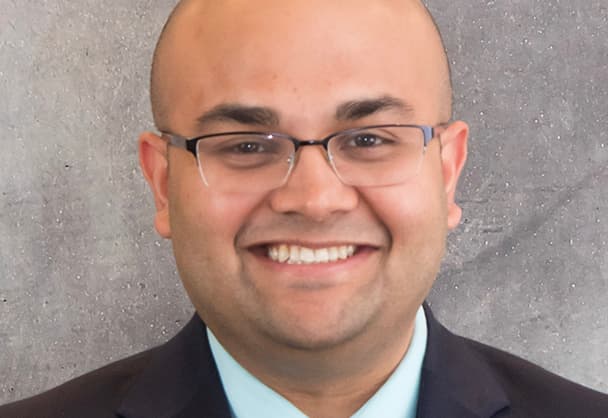Allegheny Health Network Innovates IV Medication Management with IV Robotic Technology
Podcast Episode 4
Introduction
Like many health systems, Allegheny Health Network was challenged by the cost, compliance, and complexity of compounding sterile products (CSPs). Learn how Allegheny Health Network innovated its CSP program using advanced robotics and expert technicians, leading to enhanced safety, improved practices, and cost savings.
Participants
Host: Ken Perez, Vice President, Healthcare Policy and Government Affairs, Omnicell
Guest Expert:
Arpit Mehta, PharmD, MPH, MHA, Director of Pharmacy, Allegheny General Hospital

Arpit Mehta, PharmD, MPH, MHA
Director of Pharmacy,
Allegheny General Hospital
Episode Highlights
What were some of the supply chain issues you experienced with compounded sterile products (CSPs)?
Arpit Mehta: Similar to other facilities across the country, we outsourced a lot of our ready-to-use medications from 503B vendors, primarily critical care drips, such as norepinephrine, phenylephrine, and vasopressin. Also some OR syringes like ephedrine, neostigmine, phenylephrine, succinylcholine, and others.
The challenge was balancing demand with inventory on hand to reduce waste.
For example, during the winter months, our vasopressin and norepinephrine usage would increase significantly but we couldn’t get the supply that we need. We would compound the medications in our clean rooms, but were constrained by beyond-use dating. This prevented us from putting medications at room temperature in automatic dispensing cabinets or anesthesia carts.
How did these supply chain issues impact operational and clinical decisions?
Arpit Mehta: This became a huge inventory management concern. It was a constant struggle to keep up with the demand that we had. Certainly, shortages played a huge role in in hindering our day to day operations—trying to balance inventory versus what we needed, when we needed it.
When our 503B vendor went out of business, we switched to another 503B vendor. That company also ultimately went out of business.
I would go to our hospital nursing huddle on a daily basis and have to discuss the shortages. I remember seeing the look on their faces when I told them, “Today we have fentanyl, tomorrow we have dilaudid.”
We knew we needed to get ahead of the problem, that we needed to get control over our inventory. After conversations with the VP of Pharmacy and the hospital CEO, we started exploring solutions.
What other challenges did you uncover during your analysis?
Arpit Mehta: It’s important for us to have standardization in our cleanrooms, so that we are consistently using the same compounding processes, not only in the hospital, but across the health system. That we follow the same beyond-use dating procedures, completing all documentation the same way, and so forth. Standardization allows us to run reports and do data analytics on the back end to improve efficiency, and to ensure safety and quality for all preps across the network.
Why did you choose the IV robotics service solution?
Arpit Mehta: We were struggling to fill our regular technician positions. We didn’t want an automation solution that required us to rotate a group of technicians through to learn the technology and to compound the medications. We decided on the Omnicell service program that provides the staff to help run the robotics compounding program.
The experience has been amazing. It really helped us focus, prioritize, and have technicians dedicated to the robot. They know the robot inside and out. They know the capacity, they can push the capacity to the limits. It’s helped us really expand the program quite a bit.
How did your operational processes change with IV robotics?
Arpit Mehta: “If you don’t measure, you don’t know.” That’s the challenge with manual compounding – there’s no way to measure accuracy. With our automated solutions, each prep is measured with gravimetric / volumetric verification. It gives us 100% confidence that everything we compounded in cleanrooms is accurate.
Another key is having a dedicated cleanroom supervisor and a well-trained team. It’s helped us to ensure appropriate processes are followed for checking the medications for robot compounding, for the quarantine process, for controlled substance management, and for tracking all production, minimizing waste, and things of that sort.
What has IV robotics solution enabled you to do?
Arpit Mehta: The operational benefits have been tremendous. We’re saving a great amount of time because we no longer are trying to figure out what we have on hand and what to compound. Just the shortage management piece has been huge. We’ve been able to produce what we want, when we want, and to reduce waste.
From a financial perspective, it’s been a huge success for us. We used to spend about $2.5 million with 503B vendors. By insourcing with the robot and service technicians, just in the last year—and really, it’s only six months of production—we’ve saved almost $700,000. And that’s after paying for the robot and service.
Clinically, it’s great because we don’t have to decide whether we were going to use fentanyl today or dilaudid. The clinical team can make that decision, without operational challenges dictating that patient decision.
DISCLAIMER
The Future of Pharmacy Podcast is produced and distributed by Pharmacy Podcast Network. The views and opinions expressed in this podcast are those of the authors and do not necessarily reflect the official policy or position of any other agency, organization, employer or company. Assumptions made in the analysis are not reflective of the position of any entity other than the author(s). These views are always subject to change, revision, and rethinking at any time and may not be held in perpetuity.
 Back to Podcast
Back to Podcast

